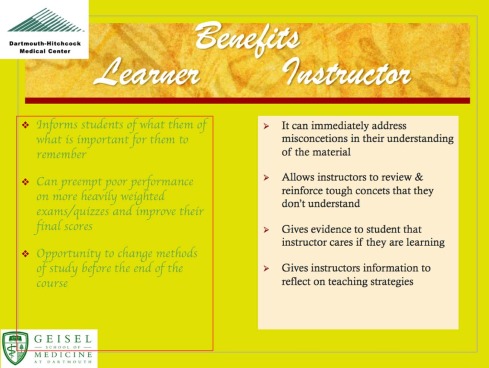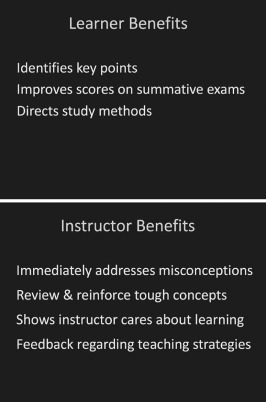Many didactic lectures induce a cognitive load in learners out of proportion to the content that they need to learn (or can learn) during that teaching session. This is due in part to the content, and in part to the way it is displayed or presented. By reducing the cognitive load on our audience, we can increase long-term retention of information. This article briefly summarizes some of the science behind cognitive load as it relates to presentations, and identifies simple steps to reduce it, while maximizing learning.
During my academic career, I have lectured using transparent overheads, Diazo slides, animated PowerPoints, graphical pads, a tablet-PC and now a wireless iPad. As a self-confessed geek, I love the tools and am always looking for creative ways to make teaching more interactive and effective, while avoiding focusing on the tool rather than the teaching. For most educators, the “tool” of choice for 20 years has been either PowerPoint (Microsoft, Redmond, WA) or Keynote (Apple, Cupertino, CA). For the rest of this paper, I will only refer to PowerPoint, but the same principles apply to all digital slide software.
These programs were a huge leap forward for educators—they gave us the ability to make and edit attractive slides much faster and cheaper than previously. With traditional slide carousels, we changed from single projectors to dual projectors so we could present two carousels of slides during one lecture—often with disastrous consequences as the audience tried to follow two uncoordinated slide sets. The advent of digital projection thankfully put an end to the dual projection, but brought with it a whole new potential world of presentation excess. Now we could use an incredible array of irresistible color schemes and fonts, and add slide transitions, animations, and even sound effects. What fun!
With tools that can turn a simple lecture into a Cirque du Soleil performance, how do we start to construct lectures? Usually by looking at texts or literature and cramming everything about that topic onto the magic 60 slides that we have learnt is the “right” amount for a 1-hour lecture (that number incidently came from the maximum number of slides that could be fitted into a carousel). Then we add our images. The result of these time-consuming endeavors is frequently cognitive overload in our learners and a lack of long-term learning. There are multiple components to a successful teaching session aside from the slide content such as the development of appropriate and focused learning objectives; using active learning methods and our oral presentation skills. In this article, however, I am going to focus on the concept of “cognitive overload,” and how we can change the format and content of conventional didactic lectures to reduce cognitive overload while maximizing learning.
Cognitive Load
Cognitive load is the stress put on our brain when we learn new data or skills . Cognitive load exists due to the limitations of our working memory. Working memory (formally called “short-term memory”) is the part of our brain which enables the processing and storage of information into long-term memory. Working memory has a very small capacity—thought to be able to hold only 7 ± 2 pieces of information at any one time—and information contained in short-term memory has to be either moved to long-term memory very fast, or it is lost . In this way, it is similar to the Random Accessed Memory (RAM) on your computer as it processes information to be stored on the hard disc. Cognitive load is affected by what we are trying to learn (simple vs complex data); how much we try to learn in any one session; how the data are presented to us and who are the learners (is the information new to us?). Cognitive overload is what happens when our working memory is overloaded by too much data too fast . When this occurs, processing slows down, and key information is not stored. Unfortunately, PowerPoint gives us plenty of opportunity to inadvertently increase the cognitive load on our learners, reducing long-term retention of information.
Information Quantity
We typically try to teach everything about the subject at hand in one session—often presenting large quantities of information in a format that might work well in a handout that could be studied at leisure, but overwhelms learners during a 45- to 60-minute lecture. We forget that for most learners, this is not their only opportunity to gain this knowledge. By overwhelming them with data, we reduce the learning of key information. We need to ask ourselves, what do we really want them to know about this condition, process, or modality? Presenting less can often result in them learning more . We can reduce cognitive load and improve memory retrieval by “chunking” related information together. If a single slide includes elements from multiple teaching points, it is much more difficult for learners to “chunk” together than if information from only one teaching point is included. Chunking is the process of taking long strings of information, grouping (chunking) them into smaller, more manageable bits of information, which has been shown to improve memory recall .
Using the Modality Effect
Get Radiology Tree app to read full this article<
Extraneous Information
Get Radiology Tree app to read full this article<
Readability Is Memorability
Get Radiology Tree app to read full this article<
Get Radiology Tree app to read full this article<
Split Attention
Get Radiology Tree app to read full this article<
Experts Versus Novices
Get Radiology Tree app to read full this article<
Making Your Slides Brain Friendly
Get Radiology Tree app to read full this article<
Get Radiology Tree app to read full this article<
Get Radiology Tree app to read full this article<
Get Radiology Tree app to read full this article<
Summary
Get Radiology Tree app to read full this article<
References
1. Sweller J.: The evolution in cognitive load theory.Clark R.Nguyen F.Sweller J.Efficiency in learning.2006.Pfeiffer (Wiley)San Francisco, CA:pp. 313-329.
2. Miller G.A.: The magical number seven, plus or minus two: some limits on our capacity for processing information. Psychol Rev 1956; 63: pp. 81-97.
3. Mayer R.E., Bove W., Bryman A., et. al.: When less is more: meaningful learning from visual and verbal summaries of science textbook lessons. J Educ Psychol 1996; 88: pp. 64-73.
4. Chase W.G., Simon H.A.: Perception in chess. Cognit Psychol 1973; 4: pp. 55-81.
5. Mayer R.: Segmenting principle.Multimedia learning.2008.Cambridge University PressCambridge, MA:
6. Baddeley A.: Working memory. Science 1992; 255: pp. 556-559.
7. Clark R., Nguyen F., Sweller J.: Use visuals and audio narration to exploit working memory resources.Efficiency in learning.2006.Pfeiffer (Wiley)San Francisco, CA:pp. 47-75.
8. Sweller J.: The Sydney Morning Herald. April 4,; Available at: http://www.smh.com.au/news/technology/powerpoint-presentations-a-disaster/2007/04/03/1175366240499.html Accessed December 27, 2015
9. Mayer R.: Coherence principle.Multimedia learning.2008.Cambridge University PressCambridge, MA:
10. Piolat A., Olive T., Kellogg R.T.: Cognitive effort during note taking. Appl Cogn Psychol 2005; 19: pp. 291-312.
11. Clark R., Nguyen F., Sweller J.: Accommodate differences in learner expertise.Efficiency in learning.2006.Pfeiffer (Wiley)San Francisco, CA:pp. 247-273.
12. Death by Powerpoint. Available from: http://www.slideshare.net/thecroaker/death-by-powerpoint Accessed November 7, 2015
13. Writing Objectives Using Bloom’s Taxonomy. Available from: http://teaching.uncc.edu/learning-resources/articles-books/best-practice/goals-objectives/writing-objectives Accessed November 7, 2015
14. Mayer R.: Signaling principle.Multimedia learning.2008.Cambridge University PressCambridge, MA:

